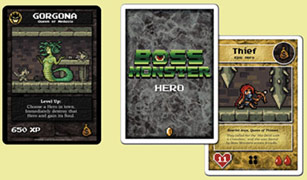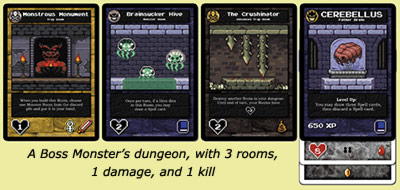by Christopher Tower

Boss Monster!
Published by Brotherwise Games (2013)
Designed by Johnny and Chris O'Neal
Ages 13+
Time: 30-60minutes
Players: 2-4
Contents: 155 Cards
$25.00
You are the Boss Monster! In this standalone card game, 2-4 players each
play as a Boss at the end of an 8-bit videogame dungeon and compete to
defeat more heroes than the other players. By laying out rooms with
traps, monsters, and treasure, players try to create a better dungeon
than their opponents.
 Boss Monster was initially funded through KickStarter, where it blew
past its fundraising goal of $12,000 and earned over $200,000.
This is the first release from Brotherwise Games, which they intend to
follow up with an expansion in the future. I backed the game and have
been playing the print-and-play preview for a few months before finally
getting a copy of the actual game. Although KickStarter backers did
receive some extra promotional cards and goodies, this review ignores
those to focus on the base game itself.
Boss Monster was initially funded through KickStarter, where it blew
past its fundraising goal of $12,000 and earned over $200,000.
This is the first release from Brotherwise Games, which they intend to
follow up with an expansion in the future. I backed the game and have
been playing the print-and-play preview for a few months before finally
getting a copy of the actual game. Although KickStarter backers did
receive some extra promotional cards and goodies, this review ignores
those to focus on the base game itself.
How does this first game from Brotherwise hold up then? It plays very
well, actually. The game is a blast to play, with interesting tactical
options and great art and design.
Components
The game comes with a full set of room, spell, boss and hero cards in a
three-section box that has plenty of room for them. The box probably has
enough space to hold the planned expansion as well, though the sections
are not large enough for sleeved cards. The cards feel thick and sturdy,
but are slightly less durable than Magic: The Gathering cards and can
show wear on their edges. That being said, while mostly consistent,
there were a few cards where the gloss didn't appear to dry all the way,
giving them a slightly different texture. The number of cards that this
affected was small and the difference isn't noticeable during play.
Gameplay
Each player is a Boss Monster, represented by a card drawn at the
beginning of the game with a special power on it. Each turn all players
play a room card from their hand, expanding or modifying their dungeon
to both protect themselves from marauding heroes and lure the unwitting
adventurers to their doom. Several heroes will come into "town" before
departing for one of the player's dungeons. This is determined by the
total amount of treasure each player has on their dungeon's room cards.
Each hero type is attracted to a certain type of treasure. Fighters are
drawn to magic weapons, clerics to holy relics, thieves to gold, and
mages to spellbooks. The heroes will enter the dungeon containing the
most loot of their preferred type. This is where the damage rating of
each room comes into play: as each hero moves into a room card, the room
causes damage to him/her. If the dungeon kills the hero before he or she
reaches the Boss, that's one soul to the Boss. If the hero survives and
reaches the Boss Monster, then the Boss gains a wound. A player wins
with 10 souls, but loses at only 5 wounds.
While the basics of the game are very simple, the cards have many
interesting effects that can enhance a dungeon or foil opponents. Every
room card has an effect on it. These vary from having an effect when
played, to affecting an opponent by sacrificing the room in the future,
doing something when a hero dies in that location, and so forth. Since
each room has a damage value, treasure, and an effect, proper room
placement is critical and there can be a lot of thought into which room
to add to your dungeon. Rooms come in two types: Traps and Monster
rooms. While this sets the theme for the room, some cards have special
interactions with one type or the other. There are also advanced rooms,
which can only be placed as an upgrade on top of another room with the
same treasure type. These rooms tend to be very powerful or help focus
the dungeon with a specific strategy. For example, a dungeon could focus
on the Crushinator, an advanced room that allows the player to sacrifice
rooms to pump up the power of the others; or the Monster's Ballroom,
which gets better for each Monster room present in the dungeon. While
these rooms will make the dungeon very powerful, the boss is going to
need it. After defeating all of the regular heroes, more powerful epic
heroes bring the game to a close, awarding double soul value for boss
monsters that kill them, but capable of dealing double damage.
 Even though room cards are the core of Boss Monster's gameplay, there
are also spells and the Boss "level up". Spells are powerful "instant"
effect cards that can be played from hand to power up the dungeon or
interfere with an opponent's. The spells can also have other more
strategic effects such as moving heroes around or causing all the
players to redraw their hand. Each Boss also has a level up ability that
makes them different from one another. This is a powerful effect that
occurs when the dungeon has reached maximum size (five rooms) for the first
time. The abilities are not so strong as to determine the winner, but,
when timed wisely, can help a player gain the upper hand.
Even though room cards are the core of Boss Monster's gameplay, there
are also spells and the Boss "level up". Spells are powerful "instant"
effect cards that can be played from hand to power up the dungeon or
interfere with an opponent's. The spells can also have other more
strategic effects such as moving heroes around or causing all the
players to redraw their hand. Each Boss also has a level up ability that
makes them different from one another. This is a powerful effect that
occurs when the dungeon has reached maximum size (five rooms) for the first
time. The abilities are not so strong as to determine the winner, but,
when timed wisely, can help a player gain the upper hand.
The strategy of Boss Monster! is even more competitive at the
beginning. To survive and build up defenses, players dare not attract
too much attention too soon – if a dungeon cannot defeat heroes, the
goal is to not draw them to it. While you can place less treasure in
your dungeon, there's a danger of letting opponents take the lead. When
two or more players' dungeons tie for treasure (both amount and type),
the heroes that desire that type of treasure stay in the town area. New
heroes still come to town each turn though, so there can become a large
buildup until someone breaks the tie, either gaining a large number of
souls, or taking a lot of damage. This creates an interesting guessing
game of playing rooms against opponents in order to control the treasure
counts, and wondering what will be played when all the new room cards
are simultaneously revealed each round.
Art and Flavor
While the gameplay is a lot of fun and will keep people coming back, the
art of Boss Monster will bring a player to the table in the first place.
All of the cards are designed in an 8-bit style very reminiscent of
Legend of Zelda, Castlevania and similar old school videogames from that
era. In further homage, many of the cards are references originating
from old school videogames as well as roleplaying games. The Brainsucker
Hive looks like creatures from Metroid, and there appears to be an
Owlbear in the Beast Menagerie. There is even a room card whose art
imitates the cover of a classic Advanced Dungeons & Dragons book (anyone spot it in the sample images?). Since the heroes themselves
don't have abilities, there is room for flavor text on the card
describing each hero. These are often silly, such as the hero with a
magic bubble. Many of the heroes are references as well. The art and
flavor of the game hold it all together and is very high quality. While
the 8-bit style may not be for everyone, it is magnificently done and
looks great.
Conclusions
Boss Monster is a great card game that really harnesses the
sources it pays homage to while also providing a strong well-rounded
gameplay experience that will bring players back to it. Typically taking
well under an hour, it fits in well as an in-between game or as
something to carry around for spontaneous gameplay. Overall the game is
a lot of fun and winning requires a combination of luck and skill that
will keep players coming back as a fun quick game in between longer
games or during a lunch break at work.
Links:
| Similar content on OgreCave: |
|
|



 Boss Monster was initially funded through KickStarter, where it blew
past its fundraising goal of $12,000 and earned over $200,000.
This is the first release from Brotherwise Games, which they intend to
follow up with an expansion in the future. I backed the game and have
been playing the print-and-play preview for a few months before finally
getting a copy of the actual game. Although KickStarter backers did
receive some extra promotional cards and goodies, this review ignores
those to focus on the base game itself.
Boss Monster was initially funded through KickStarter, where it blew
past its fundraising goal of $12,000 and earned over $200,000.
This is the first release from Brotherwise Games, which they intend to
follow up with an expansion in the future. I backed the game and have
been playing the print-and-play preview for a few months before finally
getting a copy of the actual game. Although KickStarter backers did
receive some extra promotional cards and goodies, this review ignores
those to focus on the base game itself.
 Even though room cards are the core of Boss Monster's gameplay, there
are also spells and the Boss "level up". Spells are powerful "instant"
effect cards that can be played from hand to power up the dungeon or
interfere with an opponent's. The spells can also have other more
strategic effects such as moving heroes around or causing all the
players to redraw their hand. Each Boss also has a level up ability that
makes them different from one another. This is a powerful effect that
occurs when the dungeon has reached maximum size (five rooms) for the first
time. The abilities are not so strong as to determine the winner, but,
when timed wisely, can help a player gain the upper hand.
Even though room cards are the core of Boss Monster's gameplay, there
are also spells and the Boss "level up". Spells are powerful "instant"
effect cards that can be played from hand to power up the dungeon or
interfere with an opponent's. The spells can also have other more
strategic effects such as moving heroes around or causing all the
players to redraw their hand. Each Boss also has a level up ability that
makes them different from one another. This is a powerful effect that
occurs when the dungeon has reached maximum size (five rooms) for the first
time. The abilities are not so strong as to determine the winner, but,
when timed wisely, can help a player gain the upper hand.